SCENTS OF HOPE
Sensation Tasting Experience helps recover senses hit by Covid
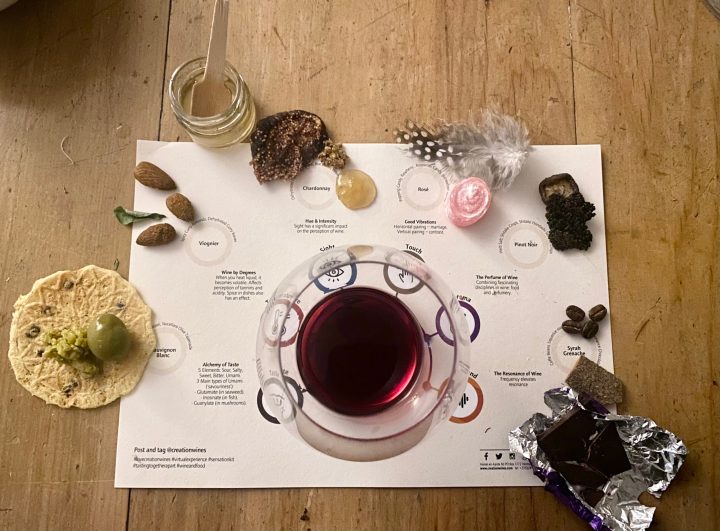
Covid patients who have lost their senses of smell and taste can be ‘trained’ to recover them. Using other senses to compensate, and being mindful and focused, can help sufferers on the long road to recuperation.
More than 500 days into pandemic lockdown now and I think we can all agree this Covid-19 nonsense is awful. It feels worse than ever now, with a constantly expanding circle of friends, family and acquaintances either desperately ill or, worse, dying. I doubt a single one of us can say we are untouched.
Today I am not going to dwell on the hideousness of it, because it’s already part of every conversation we have, and as a wise friend said recently, it probably always will. Today I am going to dwell on one particular aspect: that of the loss of taste and smell.
With all the things that can possibly go wrong, this spectre has haunted me, among the myriad other symptoms that are conceivably worse. Being able to breathe is right up there on our list of essentials. It’s not only because as a food and wine writer who takes pleasure in such things it would be a bit of an inconvenience, but it’s also incredibly disconcerting – dangerous even. You won’t know if anything’s burning, for example, whether it’s food on the stove or an electrical short or a gas leak.
I took my sense of smell for granted until I wanted to check if the milk was off. Sniffing stuff in the kitchen is a big part of my cooking experience; things may look fine but a quick whiff will tell you more.
Then there are the memories. Smell is closely linked with those and even the most ephemeral of aromas, gone before you can hang onto them and even process them fully, will evoke something from childhood or a treasured time in the past. And what about the smells you love? Cut grass, jet fuel, jasmine, your lover? The ones that make you want to breathe in forever.
“The olfactory bulb (a collection of nerves, situated above and behind the back of the nose) connects directly to the brain in two places: the amygdala and hippocampus,” says Dr Julienne Fenwick, Integrative Medical Doctor, MBChB, Best of Both Wellness in Hermanus. “These regions are strongly linked to emotion and memory. Smell is the only one of your five senses that travels through these regions. This explains why odours and fragrances can evoke powerful emotions and memories.”
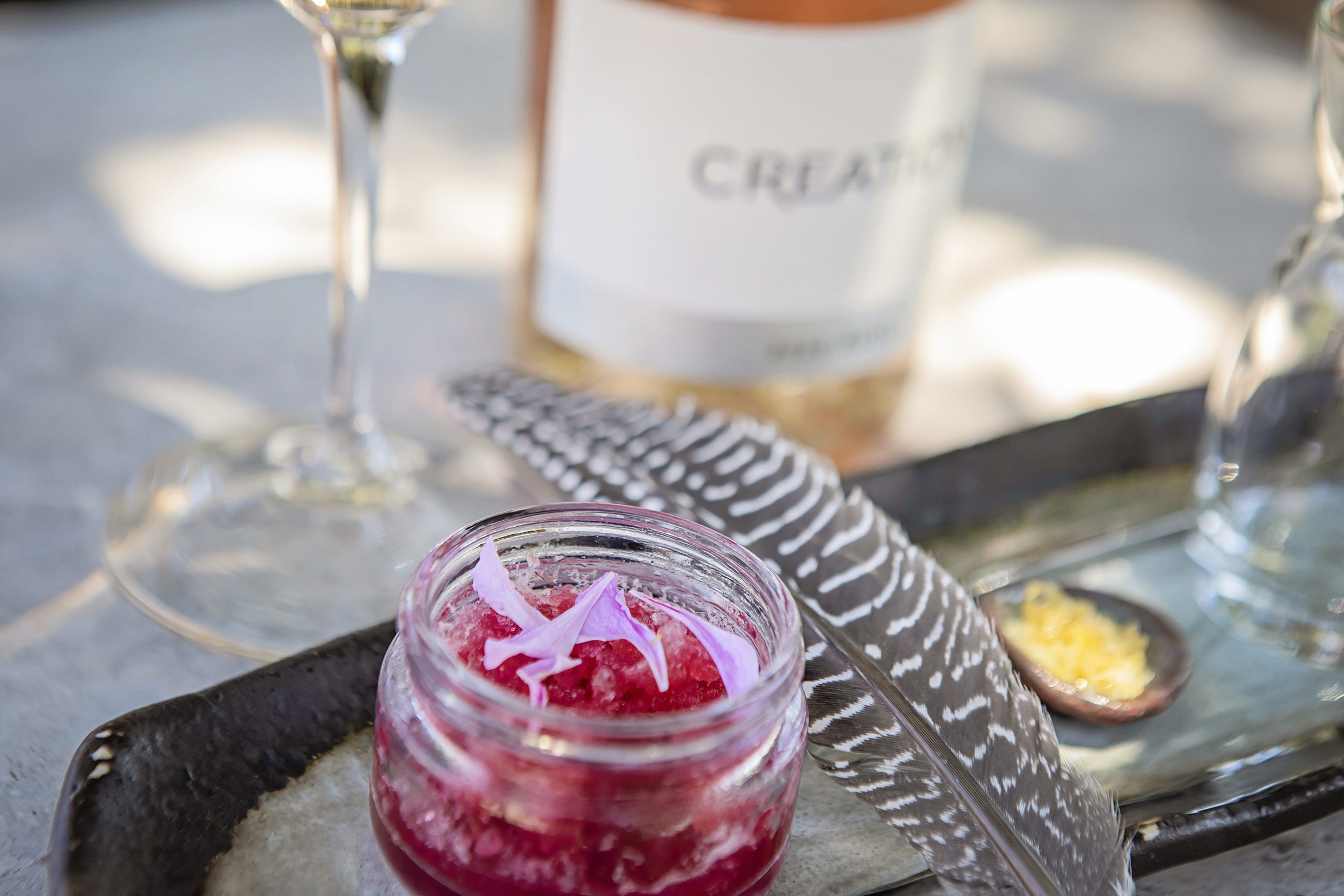
Stroking a feather down your cheek is intended to wake up those saliva glands. (Photo: Supplied)
“For example, when you smell the peaches in your favourite Viognier, you are reminded of a happy summer’s day in your grandma’s garden. Pair this with the malva pudding your mom made at Christmas, and you will likely experience a double rush of happy hormones.”
I’m almost fully vaccinated so my electronic devices are tuned into my thoughts; as I was sitting down to write this story, The New York Times morning news email delivered unto me this very morning an article about Spanish actor turned fragrance maker Ernesto Collado. “Smell goes directly to your emotions, you are crying, you don’t know why,” he said. “Smelling has a power that none of the other senses have, and I must tell you now, it is molecular, it goes to the essence of the essence.”
The effect of Covid on the palate is sometimes everything tasting nasty in the mouth, instead of not tasting at all. Päivi Brink, a Finnish freelance journalist living in Hermanus, got sick in December 2020. “When I had Covid, I could only eat yoghurt and didn’t have any appetite. I also soon realised that I can’t taste or smell properly. Many things tasted really strange. Fruit didn’t taste the way they should. Banana still doesn’t taste like banana and apple does not taste like apple, just strange general fruity flavour and a bit off. I still can’t taste if the food is off or not,” she said.
“In January, coffee tasted bitter and burned for a month, then it didn’t taste like much of anything and these days it tastes good again. I still struggle with Earl Grey tea, I don’t get the flavour right. I can’t separate black English tea from rooibos by smelling, even if before the difference was clear.
“Wine is still difficult. If I taste wine that I know, I’m often disappointed how little I taste and smell. I have recovered some of the sense of smell and taste, but not fully. It has made it harder to enjoy food and drinks, harder to separate tastes from each other and harder to tell if something is okay to eat or off.
“Oh, and my favourite perfume smells awful, just wrong! The complex smells are hard to smell right. All the smells are flat, without depth.”
As human beings, we use our five senses to position ourselves in the world, said Fenwick. “We place a great deal of value on the senses of sight, hearing, touch and taste, as these are essential for our survival on a daily basis. But what about smell?” she continued.
“Aromatherapy has been used medicinally for centuries. Massaging the body with pure essential oils, burning incense and diffusing oils in the home and work-space are all proven to calm the nerves and boost immunity. Similarly, fragrant foods and beverages that have been created with an awareness of their impact on the senses, have been used as medicine in ancient cultures, like Ayurveda, for centuries.”
For Carolyn Martin of Creation Wines in the Hemel-en-Aarde valley, taste and smell are everything. She has a highly developed nose and palate, and firmly believes in engaging all the senses for elevated food and wine experiences – even before Covid. Pairings are what the tasting room at Creation is all about, and dishes and wine have often been accompanied by sea shells to listen to, bowls of salt to sniff, and music to listen to. This is such a subtle background element but if you pause to take notice, it has an impact. The last time I was there, I noticed the bit in Tchaikovsky’s Swan Lake (Dance of the Little Swans, right at the top of a Google search; I am rocking this microchip) which reminded me of my grandmother, and her Tretchikoff print of the Dying Swan, and how many times I’ve seen this ballet.
Taking up the plight of those who have suffered the loss of the ability to taste and smell, Martin developed the Creation Sensation Tasting Experience, which is “aimed at stimulating your sensory nerves and heightening your sense of taste and smell”.
Our facial nerves connect directly to the brain stem. When we activate the vagus nerve, we identify taste, and it sticks, she said. “When we lose our sense of taste and smell and would like to improve them, we take the cranial nerves that are not working as well as they should and use the ones around them to bring them back online.”
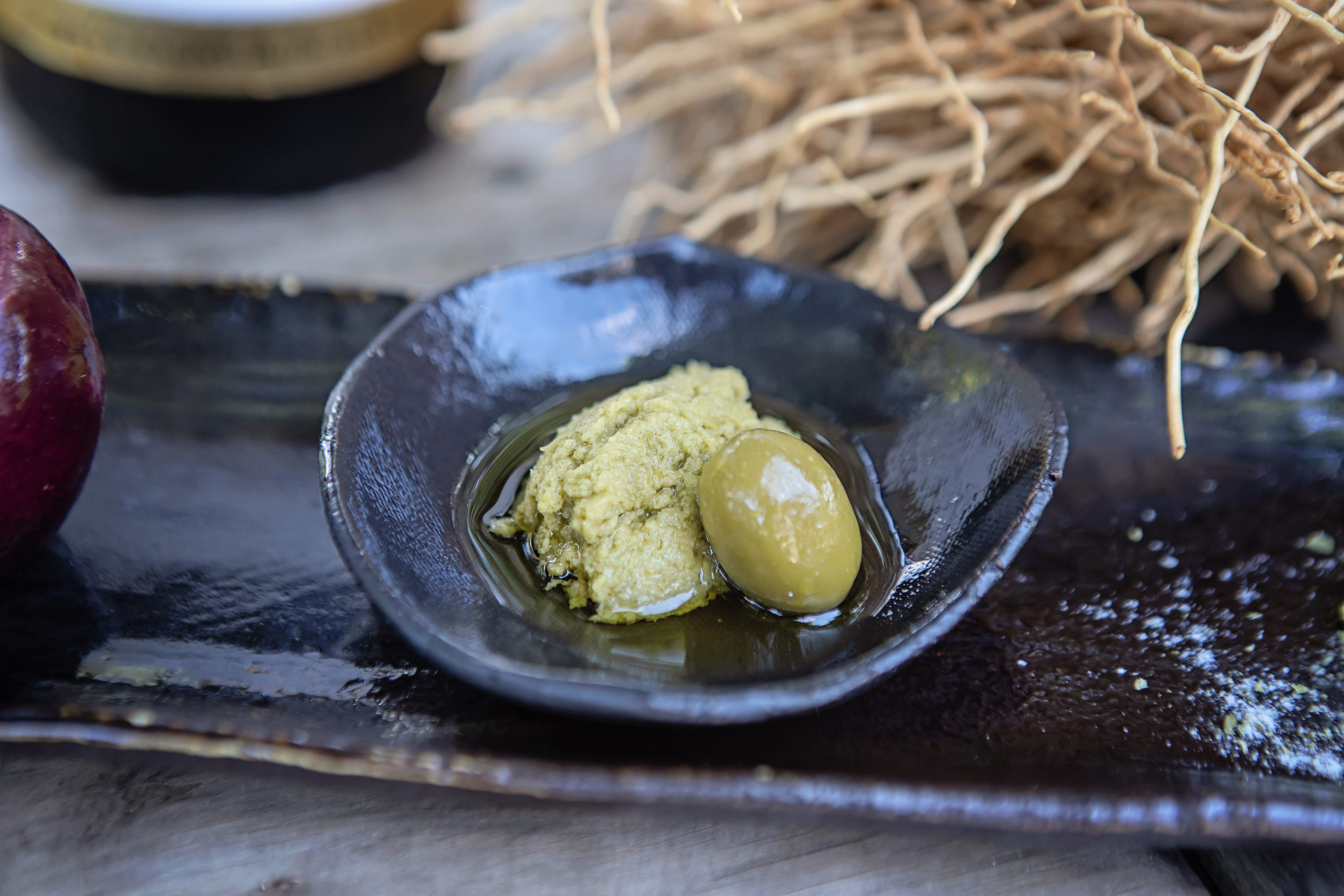
The first Sensation pairing is Sauvignon Blanc with green olive tapenade. (Photo: Supplied)
Speaking of online, the guided experience can be done via Zoom, or in the tasting room. It’s available with wine or cordials. If you do it at home, you’ll be sent a kit with sample bottles and all the food and other sensory accompaniments, as well as useful and informative cards to explain the rationale, and a Reidel tasting glass, selected because it has no “speed bump” – a thick rim which prevents the wine from flowing beautifully into your mouth. It begins with Sauvignon Blanc with green olive tapenade and a passion fruit bratzeli, then moves on to Viognier with spicy curry almonds and dehydrated curry leaves. “The spicy almonds and intensity of the curry leaves elevate and accentuate the fruity notes of peach and apricot, while balancing the creamy character of the Viognier. The bite required for the roasted almonds stimulates the trigeminal nerve which activates nearby facial and olfactory nerves,” say the tasting notes.
It’s not just any ordinary pairing though. Martin talks you through hue and intensity through sight; a Snellen chart and Ishihara are incorporated at this point, where we taste Chardonnay. What you see in your glass can affect what and how you taste. If you’ve tasted wine from a black glass, you will understand. Removing your vision makes a difference, try it.
The Chardonnay is paired with dehydrated figs, honeycomb, bee pollen, and whole grain mustard – not only for flavour enhancement but for their colours.
Your sense of touch and feel comes into play with the rosé. “Roll your shoulders and relax, stimulating your vagus nerves. The charmingly speckled guinea fowl has long been a ‘feel-good’ symbol,” said Martin. “Brush your cheek with a feather to stimulate your facial nerves and in turn, your sense of taste.”
This is a fun one, with popping candy, freeze-dried raspberry and rosewater candy. The plan is that the “popping candy releases trapped pressurised bubbles to create a unique sizzling, vibrating sound and sensation, bursting and bouncing around in your mouth. Together with stroking your cheek with a guinea fowl feather, this will stimulate different nerves, including the trigeminal and facial nerves that affect your sense of smell, taste and touch and create body awareness”.
“Freeze-dried raspberries added to the mixture heightens acidity. Put the rosewater candy on your tongue and press it flat onto your palate, stimulating the nerve that activates your tongue.”
The Pinot Noir is paired with herb salt, shiitake crisps and shiitake hondashi sesame crisps, and at this point the Perfume of Wine is introduced, a fragrance inspired by the Pinot Noir. It’s not like you can just take the wine and dab it behind your ears; the scent is made of seven essential oils with ginger as the high note, violet leaf at its heart, and earthy vetiver at the base. I find the whole thing rather sexy to wear. Plot twist: apparently we’re not supposed to rub our wrists together the way our mothers did. It causes the top notes to fade and evaporate before they can settle, now you know. I didn’t.
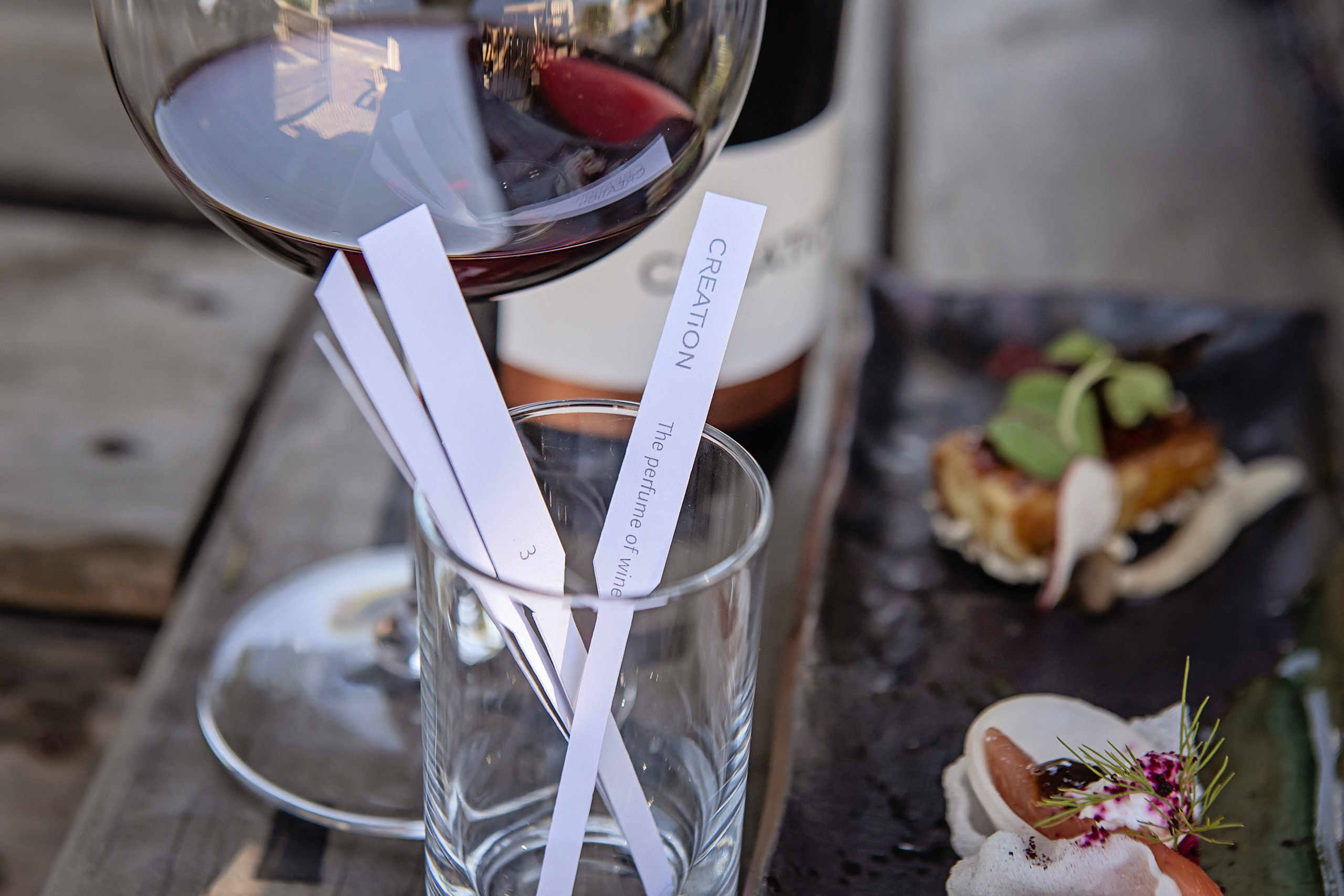
Wear wine as a personal fragrance, composed of seven essential oils with ginger, violet leaf and vetiver. (Photo: Supplied)
Syrah Grenache calls upon your sense of hearing; high-frequency sounds enhance the sweetness in food and wine, and low-frequency sounds bring out bitterness. While you ponder this, nibble on coffee beans, liquorice root, cinnamon bark (okay maybe not that but let me not stop you if you must), and chocolate, which are high in tannin.
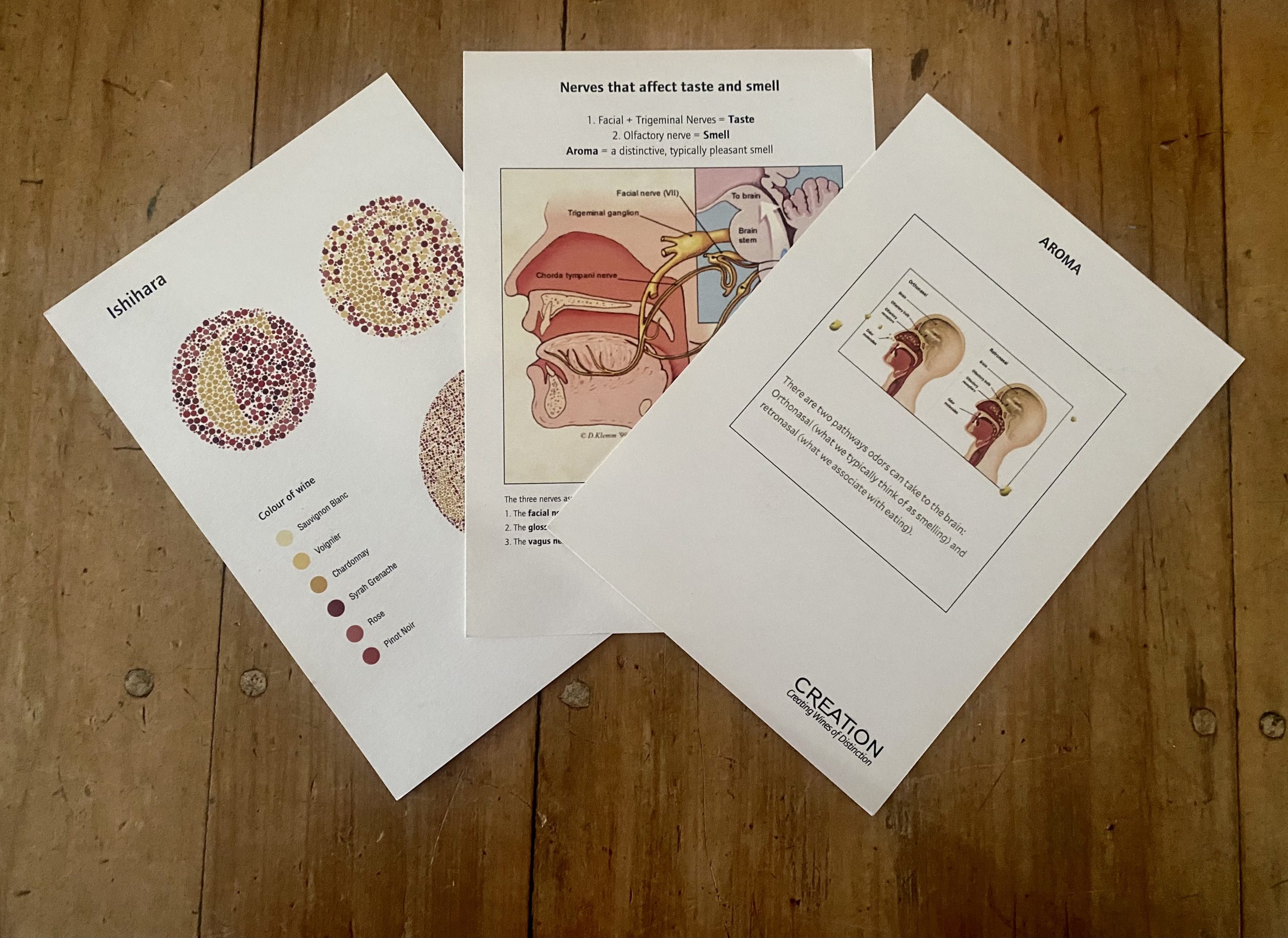
The science of taste and smell is included in the kit. (Photo: Bianca Coleman)
“We have tried to source potent flavours and let you experience how well they work with this intense yet elegant wine. Play the glass harp on the rim of your glass. Listen and taste how it changes the wine and food pairing flavours,” suggest the notes, as we watch a video of Bach’s Toccata and Fugue in D Minor played on glasses as the experience comes to a close.
“It was very interesting how different smells and tastes support each other and lift each other up,” said Brink. “The Creation Sensation Paring showed me that there are big problems in the way I smell and taste now, but it also showed that you can teach your brain to smell again.
“The pairing was done with such skill that it was like enjoying art. Concentrating on tasting and trying different combinations of taste and smell helped me notice what was easy to smell and what was difficult. It was reassuring and scary at the same time: it showed me what I can do and what I can’t, but it also gave me an idea that I can learn the skill of smelling.”
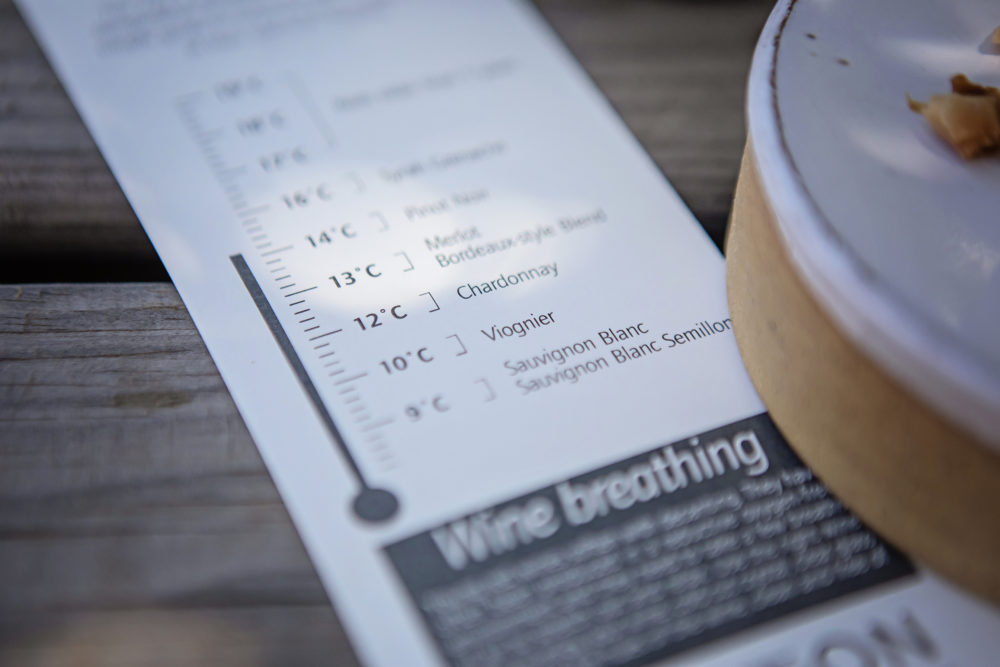
The Sensation kit includes useful information cards, including this one showing what temperature to serve your wine. Room temperature for reds in the southern hemisphere is not the same as in the north (Photo: Supplied)
Covid impairs oxygenation in the body, causing patients to feel anxious, short of breath, tired and weak, said physiotherapist Leoni Viljoen. “Physiotherapy treatment aims to support patients through this difficult time and aid in recovery.
“Unfortunately there is nothing we as physiotherapists can do to improve taste or smell for affected patients – not that I have come across in my research anyway. What I discussed with Carolyn when we did the Sensation Pairing with her, was the contrast I experienced in a single day where in the morning: I was suited up and covered to the hilt in PPE taped together with masking tape, masks, visors, and goggles all steaming up in the heat (of battle) working with our patients trying to make a difference.
“Patients are at varying levels of seriousness, some too exhausted to move, while others require ventilators to ventilate their lungs. We’ve seen many patients having to fight for their lives. Some of the patients could not smell or taste but that was the least of their (or our) concerns.
“Then in the afternoon I was fortunate enough to experience the Sensation Pairing with Carolyn and I was hit with the contrast in how fortunate we were to be healthy and have the benefit of our senses – and how wonderful these senses make our experience of life, which we often take for granted.
“I mentioned this to Carolyn and we thought of how we could assist these patients; if we can’t do it via taste and smell, what about sound (music)? ICU is usually a cacophony of alarms and beeps, people coughing and feet moving, so Carolyn volunteered to get a musician/conductor/composer friend to put together some CDs with classical music that we could then play in the ICU so patients had some calming, sensory stimulation.”
Viljoen’s view is that a person is the sum total of all the functions, sensations, anatomy, spirit, and how these integrate with each other. “Although our focus as therapists may be on the physical, our practice follows a more holistic approach of treating the cause of pain, rather than merely alleviating symptoms of pain. As our knowledge of the human body with its integrated complexity has grown, so has our world of physiotherapy expanded tremendously over the years to offer an ever increasing range of treatment to assist in healing.”
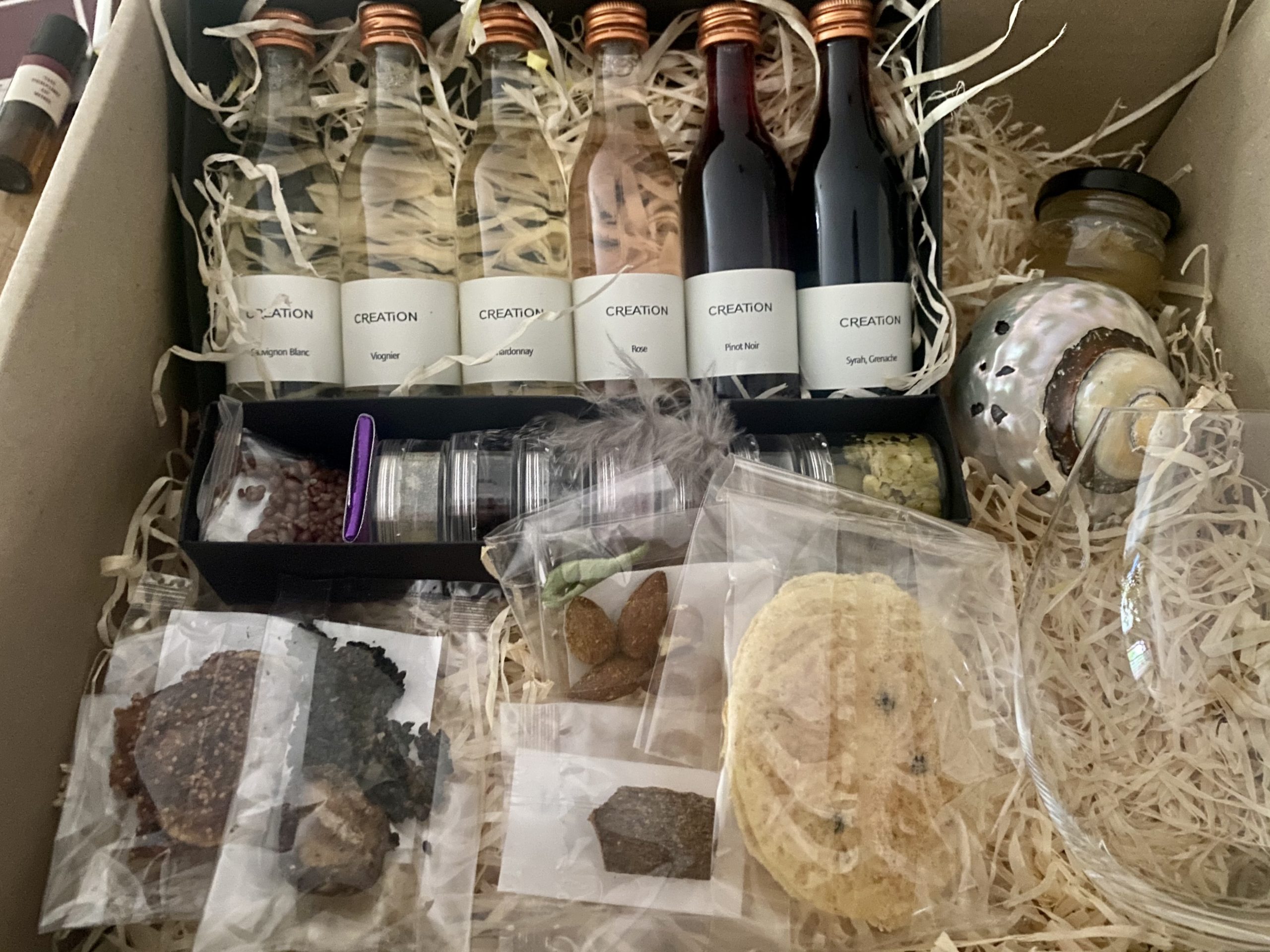
The Sensation Tasting Experience kit which can be delivered to your home. (Photo: Bianca Coleman)
Creation has managed to create a truly therapeutic experience with its Sensation Experience, said Fenwick. “Besides balancing your senses and easing your mind, every dish on the menu can be ordered with a gluten and dairy free, low-sugar option, proving that we can have the best of both worlds… delicious food as medicine. I happily prescribe this to my patients.
“I recently managed a case where a patient suffered from anosmia (loss of smell) secondary to Covid-19 infection. She also had symptoms of low mood (depression) and anxiety for the first time in her life, which one can easily put down to being an appropriate response to severe illness. Most doctors would then offer symptomatic medication.
“As a holistic medical doctor, I decided to prescribe a month of smell-retraining exercises to the above-mentioned patient to see if her mood would lift when she started to regain her sense of smell. She followed a modified version of Dr Thomas Hummel’s olfactory training programme: sniffing the essential oils of lavender, cinnamon, citrus and rosemary for 20 seconds each; twice per day. I asked her to document what she could identify from each smell, and how it made her feel (all on a scale of one to five).
“In the first week, she could not identify any smells, nor did she feel any emotions when smelling the oils. Slowly, over the next two weeks she began to identify unpleasant smells that did not make any sense (for example, she smelled old garbage in the place of rosemary, a phenomenon known as parosmia), along with feelings of fear.
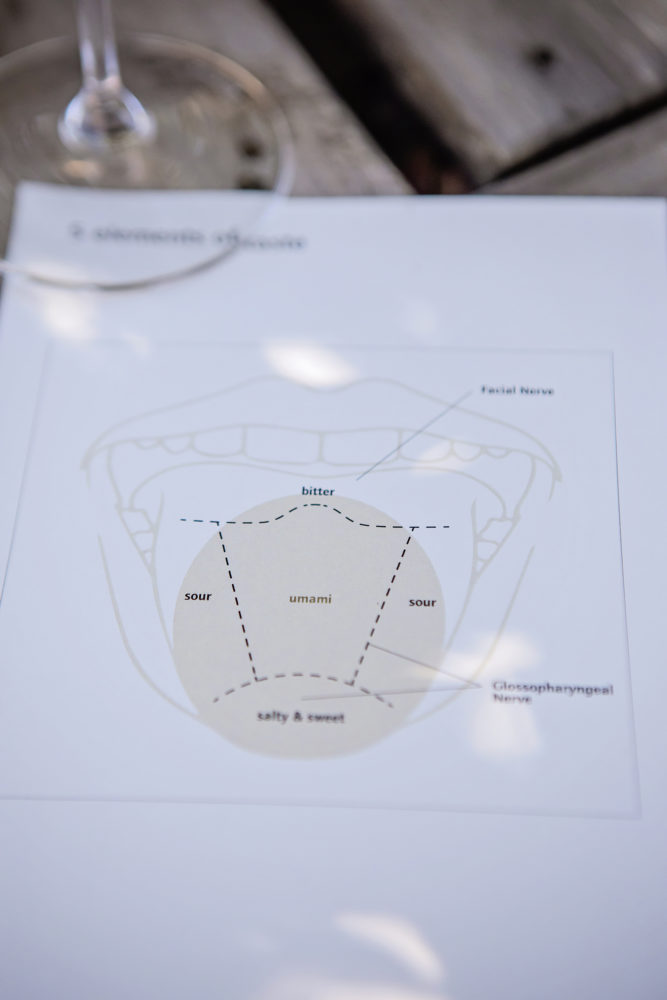
The tongue map is often interpreted that different sections of the tongue are exclusively responsible for different basic tastes. You can taste all over; some zones are more intense. And bitter is at the very back which is why swallowing pills wrong is horrible. (Photo: Supplied)
“After the fourth week of smell-retraining, my patient described having an elevated mood and a sense of well-being. This coincided with her being able to accurately identify each of the four essential oil smells. She had regained her fifth sense and her depression and anxiety had resolved!”
I don’t know about you, but right now I’m happy to take even one success story. DM/TGIFood
For more information, click here.
The writer supports The Gift of the Givers Foundation, the largest disaster response non-governmental organisation of African origin on the African continent.






 Become an Insider
Become an Insider
Comments - Please login in order to comment.